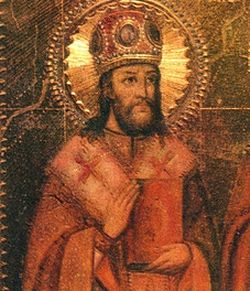 Saint Herman, Archbishop of Kazan, lived during the sixteenth century. He was born in the city of Staritsa, and was descended from the old boyar nobility of the Polevi. In his youth Gregory (his baptismal name) was tonsured at the Joseph-Volokolamsk monastery under Igumen Gurias, who later became Archbishop of Kazan (December 5). (St Gurias was head of the monastery from 1542 to 1551).
Saint Herman, Archbishop of Kazan, lived during the sixteenth century. He was born in the city of Staritsa, and was descended from the old boyar nobility of the Polevi. In his youth Gregory (his baptismal name) was tonsured at the Joseph-Volokolamsk monastery under Igumen Gurias, who later became Archbishop of Kazan (December 5). (St Gurias was head of the monastery from 1542 to 1551).
At the monastery St Herman occupied himself with copying books, and he was a close friend of St Maximus the Greek (January 21), who was living there in confinement. In 1551 the brethren of the Staritsa Dormition monastery, seeing his piety, chose him as their archimandrite.
Taking up the governance of this monastery with a pastoral zeal, St Herman concerned himself with its internal and external order, for he himself was a model of humility and meekness. He exhorted all to observe their monastic commitment strictly, and he introduced into his monastery the Rule of St Joseph of Volokolamsk (October 18).
But after two and a half years Archimandrite Herman left the Staritsa monastery, leaving its direction to the hieromonk Job (June 19), who afterwards was to become the first Patriarch of Moscow, and was an ascetic and sufferer for the Russian Land.
St Herman’s love for solitary struggles brought him to return to his original Volokolamsk monastery, where he strove toward salvation as a simple monk. However, when the new heretic Matthew Bashkin (who refused to acknowledge the Holy Mysteries and denied faith in the Holy Trinity) appeared at Moscow, St Herman and his own father (who had received tonsure at the Volokolamsk monastery with the name Philotheus) were summoned to the Moscow Council of 1553. The Council censured the heretic Bashkin and resolved to send him for correction to St Herman at the Volokolamsk monastery, since St Herman was known for his holy life and zeal for the faith in Christ.
In 1555, after the taking of Kazan, an archepiscopal See was established there. St Gurias, the former igumen of Volokolamsk monastery, was chosen as archbishop. He was entrusted with building the Dormition monastery in the city of Sviyazhsk for missionary purposes. By decree of St Gurias, St Herman was appointed as head of this new monastery in Sviyazhsk. A stone cathedral was built with a belltower and monastic cells. The igumen of the monastery lived very frugally in a cramped cell beneath the cathedral belltower. St Herman particularly concerned himself with acquiring a library for the monastery.
Soon his monastery became famous for its good works, and it became a center of enlightenment for the Kazan region.
On March 12, 1564, after the repose of St Gurias, St Herman was consecrated Bishop of Kazan. The short duration of his tenure there was marked nonetheless by his efforts to build churches and to enlighten the people of the region with the light of Christ.
In 1566, Ivan the Terrible summoned St Herman to Moscow and ordered that he be elected to the Metropolitan cathedra. At first, St Herman refused to have this burden imposed upon him. The Tsar would not tolerate any objection, however, and the saint was obliged to settle into the Metropolitan’s quarters until his elevation to the position of Metropolitan.
Seeing injustice among those of the Tsar’s inner circle, St Herman, true to his pastoral duty, attempted to admonish the Tsar. “You are not yet elevated to Metropolitan, and already you place constraints upon my freedom,” the Tsar told him through his aides. He ordered St Herman expelled from the Metropolitan’s quarters and that he be kept under surveillance.
The saint lived in disgrace for about two years, and died on November 6, 1567. They buried him in the church of St Nicholas the Hospitable. In 1595, at the request of the inhabitants of Sviyazhsk, the relics of the saint were transferred from Moscow to the Sviyazhsk Dormition monastery. St Hermogenes, then Metropolitan of Kazan, visited his grave.
St Herman is also commemorated on September 25 (first translation of his relics in 1595) and June 23 (second translation of his relics in 1714).



